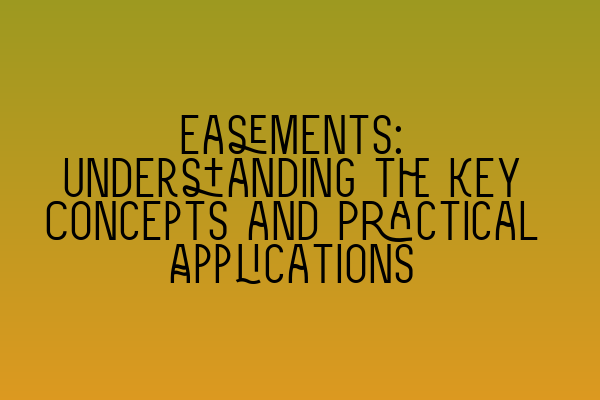Easements: Understanding the Key Concepts and Practical Applications
When it comes to property law, there are various legal concepts and principles that individuals must be familiar with. One such concept is easements, which plays a crucial role in property ownership and use. In this article, we will delve into the key concepts and practical applications of easements, providing you with a comprehensive understanding of this important aspect of property law.
What is an Easement?
An easement is a legal right granted to a person or entity allowing them a nonpossessory interest in someone else’s property. It grants the easement holder certain rights over the property, typically for a specific purpose. These rights are usually limited to the use and enjoyment of certain portions of the property, while the legal ownership of the property itself remains with the owner.
Common examples of easements include rights of way, which allow individuals to pass through another person’s land, and easements for utilities, which permit utility companies to install and maintain utility lines on private property. Easements can also pertain to issues such as drainage, light, and air, among others.
Types of Easements
There are several types of easements, each serving a different purpose and conferring different rights upon the easement holder. Here are some common types of easements:
- Express Easements: These are easements that are created by an explicit agreement between the property owner and the easement holder. The terms and conditions of the easement are typically documented in a written contract or deed, ensuring clarity and legal enforceability.
- Implied Easements: Implied easements are not explicitly stated but are instead implied from the circumstances or actions of the parties involved. For example, if a landlocked property has no access to the public road except through a neighboring property, an implied easement may be created for the landlocked property to access the road.
- Prescriptive Easements: Prescriptive easements are easements that are created through prolonged and uninterrupted use of another person’s property without permission. To establish a prescriptive easement, the use must be hostile (without the owner’s permission), open and notorious (obvious to the owner), continuous, and uninterrupted for a statutory period of time, which varies by jurisdiction.
- Easements by Necessity: Easements by necessity are created when a property owner has no other reasonable access to their property except through another person’s land. This type of easement ensures that property owners have essential access to their property.
Practical Applications of Easements
Now that we have explored the various types of easements, let’s discuss some practical applications of easements and how they apply in real-life scenarios:
1. Rights of Way: Rights of way easements are commonly used in situations where there is no direct access to a public road. For example, if a property is landlocked and surrounded by other privately owned properties, the owner may seek a right of way easement to ensure they have a legal right to access their property through a neighboring parcel.
2. Utilities: Easements for utilities are another common application. Utility companies often require easements to install, maintain, and repair utility lines, such as electrical cables, water pipes, or gas lines, on private properties. These easements ensure that the utility companies can access the necessary areas to provide essential services to the community.
3. Drainage: Easements related to drainage aim to prevent water-related issues such as flooding. In some cases, neighboring properties may enter into agreements allowing the diversion or channeling of water through easements in order to protect their properties from potential damage caused by water accumulation.
4. Light and Air: Easements for light and air are relevant in urban areas where buildings can obstruct natural light and airflow. These easements preserve the rights of property owners to enjoy natural light and ventilation by restricting the height or construction of nearby buildings that may impede these rights.
Conclusion
Easements are a fundamental aspect of property law. Understanding the key concepts and practical applications of easements is crucial for property owners, developers, and anyone involved in real estate transactions. Whether you are granting or seeking an easement, it is essential to consult with a qualified property law solicitor to ensure that your rights and interests are protected.
To further enhance your understanding of legal concepts and principles, we recommend reading the following related articles:
